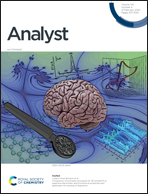Label-free electrochemical immunosensor based on biocompatible nanoporous Fe3O4 and biotin–streptavidin system for sensitive detection of zearalenone†
Abstract
In this study, a sensitive label-free electrochemical immunosensor was designed based on nanoporous Fe3O4 and a biotin–streptavidin system to specifically detect zearalenone (ZEN). Herein, nanoporous Fe3O4 was employed to carry streptavidin to prepare the highly sensitive immunosensor. The application of nanoporous Fe3O4 and the biotin–streptavidin reaction provided large amounts of antibodies on each conjugate, thus amplifying the detected signal. Cyclic voltammetry (CV) and electrochemical impedance spectroscopy (EIS) were conducted to characterize the modification with ZEN. Factors which might influence the properties of the immunosensor, including concentration of nanoporous Fe3O4, pH of the buffer, incubation time and temperature were studied. Under the best conditions, the immunosensor displayed a highly sensitive response toward ZEN, ranging in concentration from 10.0 pg mL−1 to 3.00 ng mL−1 and 3.00 ng mL−1 to 12.0 ng mL−1, with a low detection limit of 3.7 pg mL−1. The results for analysis of human urine samples were satisfactory. Furthermore, this proposed method may find promising applications in the detection of other mycotoxins.



 Please wait while we load your content...
Please wait while we load your content...